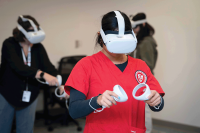Welcome to the “Year of the Healthy Nurse.” In 2017, ANA is launching a yearlong campaign focusing on the health, safety, and wellness of RNs by promoting content and activities on health-related topics. In January, we’re highlighting the theme of worksite wellness.
How can worksite wellness programs contribute to the health of RNs? According to the Centers for Disease Control and Prevention, a worksite wellness program includes a health-promotion activity or an organization-wide policy designed to support healthy behaviors and improve health outcomes at work. These programs may include health education and coaching, weight-management programs, medical screenings, and access to onsite fitness programs. (See ANA’s Health Risk Appraisal results.)
One major aim of worksite wellness programs is to reduce chronic disease among employees. Diseases like heart disease, diabetes, and depression reduce productivity, affect quality of life, and increase healthcare costs. Worksite wellness programs strive to reverse these trends and increase employee retention and satisfaction. Furthermore, what’s good for nurses is good for patients: Nurse wellness and healthy work environments can also improve patient satisfaction and outcomes.
Defining worksite wellness
ANA defines a healthy nurse as one who focuses actively on creating and maintaining a balance and synergy of physical, intellectual, emotional, social, spiritual, personal, and professional well-being. The National Wellness Institute defines wellness as “an active process through which people become aware of, and make choices toward, a more successful existence.” To be well isn’t simply to lack illness or injury; it’s to pursue the best possible quality of life.
The Substance Abuse and Mental Health Services Administration has outlined eight dimensions of wellness.
1. Emotional: coping effectively with life and creating satisfying relationships
2. Environmental: experiencing good health by occupying pleasant, stimulating environments that support well-being
3. Financial: achieving satisfaction with current and future financial situations
4. Intellectual: recognizing creative abilities and finding ways to expand knowledge and skills
5. Occupational: gaining personal satisfaction and enrichment from one’s work
6. Physical: recognizing the need for physical activity, healthy foods, and sleep
7. Social: developing a sense of connection, belonging, and a well-developed support system
8. Spiritual: expanding a sense of purpose and meaning in life.
The work environments of RNs often intersect with all eight dimensions of wellness. Relationships among emotional, physical, and occupational wellness are particularly relevant as nurses encounter high levels of stress, fatigue, and hazards, such as manual patient lifting and workplace violence.
Spotlight on worksite wellness programs
Creative delivery and incentives enhance participation in employee wellness programs. Here are two examples of organizations that have used these strategies successfully to engage their employees.
Northwell Health
In May 2016, the Employee Wellness Team at Northwell Health kicked off the final challenge of “myWellness year,” called “Walk the Wonders.” The 8-week challenge encouraged team members to take a virtual trip to all of the Wonders of the World, starting at Lisbon, Portugal and ending at the Great Wall of China. The whole trip required a team of up to 11 participants to walk a total of 4 million steps within the 8-week period.
More than 6,000 team members participated by walking and tracking their steps using the virtual platform at least four times per week. This challenge focused on awareness of team members’ amount of physical activity rather than meeting a specific step threshold. Based on the number of steps individuals or teams completed, the virtual walk unlocked the next destination and provided participants with educational information, recipes, and videos to create a real-world experience.
By the end of the 8-week challenge, 27% of the participants had lost weight, 71% said the challenge helped them reduce stress, 66% felt more connected to their colleagues, and 68% said they have more energy. At the conclusion of “myWellness year,” President and CEO Michael J. Dowling raffled off 16 trips to anywhere in the world to participants on the myWellness platform.
“This was a very motivating, engaging and team-building experience,” said Maureen White, MBA, RN, CNAA, NEA-BC, senior vice president and chief nurse executive, and an ANA member. “The enthusiasm it generated was palpable around the organization. We look forward to learning where our 2017 walking challenge will take us.”
Valley Health System
At Valley Health System in Ridgewood, NJ, the employee health and wellness department is committed to the health of Valley’s employees. Throughout the year, the department runs a variety of health and wellness initiatives, including “It’s Your Move,” Weight Watchers, a year-round weight-loss competition, an employee assistance program (EAP), discounted fitness classes, and self-management programs for asthma, diabetes, and COPD.
“It’s Your Move” rewards employees for taking care of themselves through three simple steps— obtaining their biometric data, completing an online health risk assessment, and visiting their personal healthcare provider at least once a year. Employees whose results are concerning receive health coaching to help them to manage such conditions as prediabetes or high cholesterol levels.
The EAP provides assessment and evaluation, crisis intervention, problem identification, counseling, coaching, case management, referral, and follow-up services for employees experiencing emotional stress, mental health disorders, family or relationship difficulties, financial or legal concerns, and alcohol or drug abuse problems.
In 2015, Valley implemented a policy requiring all employees to receive flu shots. By the end of 2015, Valley had a final compliance rate of 92%. (This statistic doesn’t include staff turnover or employees who declined or had medical or religious exemptions.)
Finally, to monitor the success of its programs, the department tracks metrics and outcomes. This allows programs to be adjusted or instituted as necessary to better serve hospital employees.
Visit nursingworld.org to learn more about the “Year of the Healthy Nurse” and the Healthy Nurse, Healthy Nation™ Grand Challenge!
Jaime Murphy Dawson is director of program operations for Nursing Practice and Innovation at ANA.



















